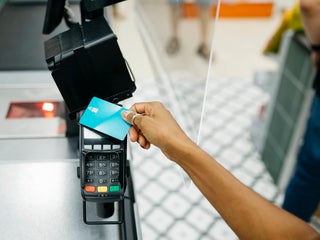Summary
Even in the wake of the COVID-19 pandemic, American credit scores still steadily trend upward year-over-year while overall credit card debt and utilization ratios decrease.
The content on this page is accurate as of the posting date; however, some of our partner offers may have expired. Please review our list of best credit cards, or use our CardMatch™ tool to find cards matched to your needs.
If you want to know how Americans are doing financially, take a look at their credit scores.
Credit scores are key to determining whether someone will qualify for a mortgage, loan or credit card and how much interest they’ll pay. They also help shed light on people’s financial situations. Despite the pandemic, credit scores rose and average credit card debt fell, according to Experian’s annual State of Credit report.
- The average VantageScore is 695.
- The average FICO score in the U.S. is 716.
- Average credit card debt fell to $5,525 between 2020 and 2021.
- Minnesota has the highest VantageScore average at 726.
- Mississippi has the lowest VantageScore average at 666.
Average credit score in the U.S.
Research by Experian shows that the average VantageScore in the U.S. in 2021 is 695, and the median is 707. This is a slight increase from the previous year, where the average score was 688, and the median was 697. And the average FICO score currently sits at 716.[1]
Average credit scores have been trending upward since the Great Recession when many people were struggling with layoffs, underwater mortgages and other financial problems. Despite the pandemic and its associated unemployment rates, credit score averages in the U.S. are up 20 points from pre-COVID levels.
Consumers with the highest and lowest credit scores
Baby boomers and members of the Silent Generation – many of whom are homeowners with substantial savings – enjoy some of the highest credit scores. The oldest borrowers studied by Experian, for example, had an average credit score of 729 in 2021, while baby boomers enjoyed an average score of 724. Members of Generation X fare significantly worse, averaging just a 685 VantageScore.
Not surprisingly, young and inexperienced borrowers have the lowest credit scores, on average – but they’re improving. Millennials, for example, averaged a 667 credit score (up from 658 in 2020), while members of Generation Z averaged a 660 score (from 654 the prior year).
Average VantageScore by generation
| Age group | 2020 | 2021 |
|---|---|---|
| Silent Generation | 729 | 729 |
| Baby boomers | 716 | 724 |
| Generation X | 676 | 685 |
| Millennials | 658 | 667 |
| Generation Z | 654 | 660 |
Source: Experian[1]
Experian’s data show that although Gen Z has the lowest average credit card balance at $2,312 and Gen X has the highest average credit card balance at $7,236 in 2021 and Gen X decreased their credit utilization ratios by 6.6%. Gen Z’s average utilization ratio increased 3.6% between 2020 and 2021.
On the other hand, boomers reduced their average credit card balance from $6,474 to $6,230 and their credit utilization by 9.7% – the largest decrease among generations – from 23.7% in 2020 to 21.4% in 2021.
Experian State of Credit 2020 credit and debt statistics
| 2021 State of Credit Report | 2019 | 2020 | 2021 |
|---|---|---|---|
| Average VantageScore | 682 | 688 | 695 |
| Median VantageScore | 687 | 697 | 707 |
| Average number of credit cards | 3.0 | 3.0 | 3.0 |
| Average credit card balance | $6,494 | $5,897 | $5,525 |
| Average revolving utilization rate | 30% | 26% | 25% |
| Average number of retail credit cards | 2.50 | 2.42 | 2.33 |
| Average retail credit card balance | $1,930 | $2,044 | $1,887 |
| Average non-mortgage debt | $25,057 | $25,483 | $25,112 |
| Average mortgage debt | $210,263 | $215,655 | $229,242 |
| Average auto loan or lease | $19,034 | $19,462 | $20,505 |
| Average 30–59 days past due delinquency rates | 3.8% | 2.4% | 2.3% |
| Average 60–89 days past due delinquency rates | 1.9% | 1.3% | 1.0% |
| Average 90–180 days past due delinquency rates | 6.6% | 3.8% | 2.5% |
Source: Experian[1]
States with the highest and lowest credit scores
Minnesotans must be doing something right when it comes to managing their credit. According to Experian, for the fifth consecutive year, Minnesota residents took the nation’s top spot for highest average credit scores. The average Minnesota resident enjoys an average 726 credit score, which is high enough to qualify for a range of competitive credit products, including many of the best rewards cards.
Vermont residents came in a close second this year. According to Experian, residents of the Green Mountain State enjoy an average VantageScore of 719, up 7 points from the previous year. Meanwhile, residents of New Hampshire, Washington and Massachusetts also have average scores well above 700.
Although it’s not clear why certain states enjoy higher scores than others, the top-performing states do share something else in common. According to the Census Bureau, many of them boast relatively high median incomes. For example, the median income in Minnesota is $71,306. In New Hampshire, it’s $76,768 and in Massachusetts, it’s $81,215. The median income in the U.S., by contrast, is $62,843.[5]
Meanwhile, several states with the lowest average credit scores also have some of the lowest incomes in the country, making it tough for many residents to pay their bills. Mississippi residents not only have the lowest VantageScore on average at 666 in 2021, but in 2020, the median income was the lowest of all states at $45,081.
Louisiana residents also fare poorly in Experian’s survey – residents have a median income of just $49,469 and an average VantageScore of 669. Experian also found that average scores in Alabama, Oklahoma and Texas were among the lowest nationwide.
How payment history affects credit score
Various factors affect credit scores, including the amount of debt a person has, what kinds of credit accounts they have and how long they’ve been successfully using credit.
The single most important factor impacting a person’s credit score, though, is their payment history.
According to additional research from Experian, Americans with subprime credit scores are reducing debt and increasing their scores. Between 2020 and 2021, subprime consumers’ average FICO scores increased from 578 to 586. In addition, their average debt decreased 5% from $55,135 to $52,628 and their utilization ratios decreased from 61% to 55%.[2]
Compare that to prime borrowers, who have an average FICO score of 767 and an average credit utilization ratio of 16% in 2021. However, prime consumers have almost twice as much debt on average, at $107,956.
How to interpret your credit score
There are two major credit scoring models in the U.S.: VantageScore and FICO. Both are used by lenders and issuers when reviewing applications for credit cards and loans. While your credit scores between VantageScore and FICO might be similar, they are calculated very differently.
Here’s how FICO calculates consumer credit scores:
VantageScore takes a less transparent approach, instead opting to calculate scores like so:
How to improve your credit score
If either your VantageScore or FICO score is subprime – or just not to your liking – here’s how you can increase your credit score:
- Pay off balances and reduce your credit utilization ratio. Your credit utilization ratio makes up 30% of your FICO score and is extremely influential on your VantageScore. Reducing your credit utilization ratio will increase your credit scores.
- Connect non-traditional accounts to your file. By using Experian Boost or UltraFICO, you can report accounts like rent payments, utilities and more to the credit bureaus and increase your credit score with on-time payments on those accounts.
- Become an authorized user. If you have a trusted person with responsible credit card habits who’s willing to add you as an authorized user on their credit card, you can enjoy the fruits of their financial labor. Once added as an authorized user, their on-time payments and low revolving balances are reported to your file as well.
Consumers’ credit knowledge
Access to free credit scores has increased dramatically in recent years now that a large number of credit card issuers and personal finance sites offer complimentary access to scores. A 2020 report by Javelin Strategy and sponsored by TransUnion shows that 15% of Americans use more than four or more sources to check their credit scores, 7% use three, 17% use two sources and 38% use one source.[3]
As a result, 52% of Americans surveyed in the study checked their credit score in the past 30 days.
That same study shows consumer confidence about personal finance is significantly higher among people who check their credit score once a month. About 75% of consumers who check their credit score once a month felt they had control over their day-to-day and month-to-month finances, while only 54% of people who never monitor their score and a close 65% of people who monitor less than once a month felt the same way.[3] This trend continues for sentiments like “I have the capacity to absorb an unexpected financial shock” and “I am on track to meet my longer-term financial goals.”
Most consumers agree that financial literacy and credit knowledge are important. According to a 2020 National Financial Educators Council survey, the vast majority of consumers – 83.3% – agree that financial literacy courses should be included in school.[4]
Bottom line
Despite the pandemic leaving millions unemployed across the U.S., it’s clear Americans used the opportunity to improve their credit scores and reduce average credit card debt. The steadily increasing trends in credit scores across the country, especially in the Midwest, bode well for the economy’s future. However, some Americans could improve their participation in their own personal finances by checking their credit scores more often.
While easier said than done, improving your credit score is often a straightforward process of paying down debt and reducing credit utilization.
Sources
- Experian, “State of Credit,” 2021
- Experian, “Fewer Subprime Consumers Across U.S. in 2021”
- Javelin Strategy, “Access to Credit Scores Empowers Consumers, Strengthens the Lending Ecosystem, 2020
- National Financial Educators Council, “Americans Agree Schools Should Teach High School Students Financial Literacy Coursework,” 2020
- U.S. Census Bureau, “Median Household Income in the United States,” 2019
Editorial Disclaimer
The editorial content on this page is based solely on the objective assessment of our writers and is not driven by advertising dollars. It has not been provided or commissioned by the credit card issuers. However, we may receive compensation when you click on links to products from our partners.






